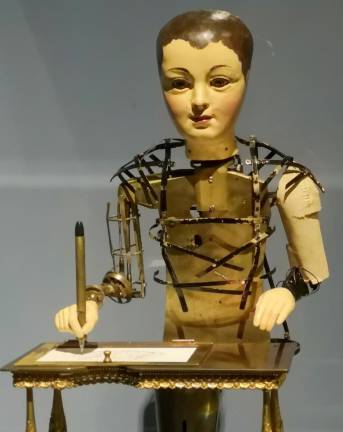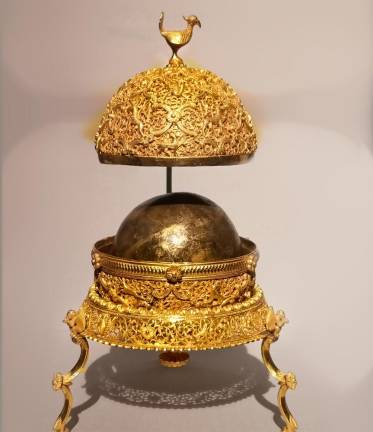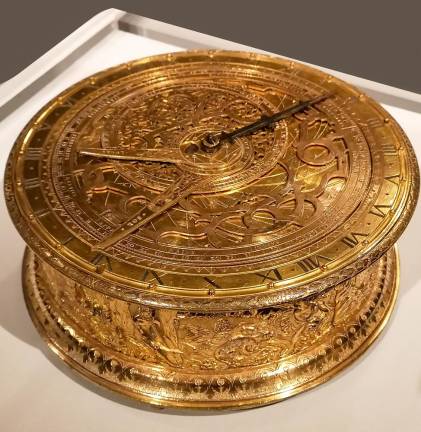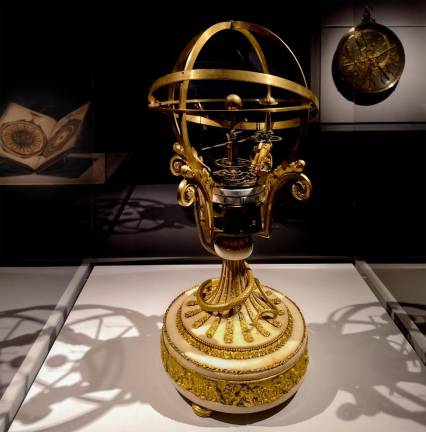The gee-whiz factor is off the charts at the Met's "Making Marvels: Science & Splendor at the Courts of Europe." A fifty-three pound solid silver fountain and basin used for chilling glasses, a 41-carat green diamond, and a selection of automatons that walk, play music and even pick up a pen and draw are decidedly jaw-dropping.
But are opulence and gadgetry enough for a show at the world's greatest museum? You can see plenty of both in store windows all over Manhattan. What turns this collection of gem-encrusted curiosities into an exhibition is the story they tell.
Art is a form of communication. The one who commissions it often determines the message. These royal knick-knacks belonged to the kings and queens, dukes and duchesses of Europe from about 1550 to 1750. They were flaunted at fancy dinners and filled Kunstkammers, or cabinets of curiosities – a popular way to display, protect and enjoy rarities like fossils or ostrich eggs – at the same time as they announced their owner's erudition.
Encyclopedic Collections
The message of these wonders of workmanship is expressed by exhibition curator, Wolfram Koeppe, in the wall text. "Scientific and artisanal knowledge was equated with the practical wisdom, self-mastery, and moral virtue required of a successful leader. Rulers proclaimed their divine right to govern by assembling encyclopedic collections that demonstrated an understanding of nature’s secrets." Met director Max Hollein noted, “The masterpieces in this exhibition, many of them precursors for some of today’s most innovative technological devices — are remarkable for their astonishing capabilities."
But there's a wider story that these objects hint at – as wide as the oceans. They focus on discoveries, inventions and engineering, from the years just after Columbus' voyage through the dawn of The Enlightenment. Travel and trade beyond Europe brought discoveries and new understanding, and the Age of Reason blossomed with advancements in science, mathematics, engineering, discourse and philosophy.
Never-before-seen shells, like those of the nautilus and coconut from distant shores, were marveled over and mounted in glittering gold stands. It was an era that celebrated curiosity and exploration, led by people like Galileo Galilei, Nicolaus Copernicus, Johannes Kepler, Isaac Newton and Francis Bacon, who is quoted in the exhibition. The support and patronage of the wealthy and the demand for the newest, most fantastic devices and rarities led to an unprecedented surge of collection, study and invention. These objects reflect that zeitgeist.
Fascinating Curios...and Automatons
One of the most visually spectacular is a Goa Stone and case from India. With three layers of gold work, encompassing carving, repoussé, and casting, it's covered in tiny animals, flowers, and decoration. Within is a spherical stone made of ground bits of bezoar (animal gallstones) gems, clay, shells, amber, musk, resin, and even narwhal tusk; the combination was believed to be an antidote for poison. It's a beautiful, fascinating curio that opens windows on different times, thoughts and cultures, as does the exhibition as a whole.
Save time for the final gallery, where machines come alive. Or try to. Automatons ranging from walking dolls, to scurrying spiders, to a portly Bacchus that raises his glass, rolls his eyes and sticks out his tongue, to an automated chess player, are astonishing, even today. Mechanical paintings with changing pictures may have been the first movies. Many of the machines are shown activated, in videos.
The most astounding is the final work in the show, "The Draughtsman-Writer." An incredibly complex set of gears drives the hand of a metal figure. It picks up a pen, puts it to paper and writes poems (two in French and one in English) and even draws sketches. Made in 1800, it revealed what might be its final secret during a 20th century restoration which activated the machine to sign its maker's name, “the automaton of Maillardet.”
During the Age of Reason, science was embraced, and the wealthiest spent lavishly to have the newest, best, most amazing gadget. Engineers, inventors, builders, and artists pushed boundaries as they jockeyed for commissions. The results far surpassed the glory of these objects. They were the foundation of the machine age, automation, mass communication and even artificial intelligence.
IF YOU GO
What: Making Marvels: Science and Splendor at the Courts of Europe
Where: The Met, 1000 Fifth Avenue Gallery 999, Iris and B. Gerald Cantor Exhibition Hall
When: Through March 1



